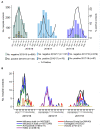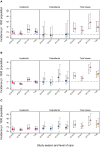The burden of hospital-attended influenza in Norwegian children
- PMID: 36160779
- PMCID: PMC9491848
- DOI: 10.3389/fped.2022.963274
The burden of hospital-attended influenza in Norwegian children
Abstract
Background: Norwegian health authorities do not recommend universal pediatric vaccination against seasonal influenza. We aimed to estimate the incidence of influenza by age and underlying medical conditions in hospitalized Norwegian children aged <18 years.
Methods: Active surveillance for influenza in children <18 years was implemented in five hospitals during 2015-18. Children with respiratory symptoms and/or fever were prospectively enrolled and tested for influenza. Surveillance data were linked to health registry data to estimate the national burden of influenza in hospitals.
Results: In 309 (10%) out of 3,010 hospital contacts, the child tested positive for influenza, corresponding to an average incidence of 0.96 hospital-attended influenza cases per 1,000 children <18 years of age. Children <1 year of age (3.8 per 1,000 children) and children with underlying medical conditions (17 per 1,000 children with bronchopulmonary dysplasia) had the highest average incidence. Among <1 year old children, 3% tested positive for influenza, compared to 25% for children aged 6-17. Few children were vaccinated against influenza.
Conclusions: Children <1 year of age and children with underlying medical conditions had a higher incidence of influenza requiring hospital treatment compared to the general population. Effective interventions against seasonal influenza for children in Norway should be considered.
Keywords: children; disease burden; hospital-attended influenza; pediatric; surveillance.
Copyright © 2022 Bøås, Bekkevold, Havdal, Kran, Rojahn, Størdal, Debes, Døllner, Nordbø, Barstad, Haarr, Vázquez Fernández, Nakstad, Leegaard, Hungnes and Flem.
Conflict of interest statement
Author EF is currently employed by Merck Sharp & Dohme Corp., Drammen, Norway, a subsidiary of Merck & Co., Inc., Kenilworth, NJ. The work for the current study was conducted by EF under the previous affiliation. The remaining authors declare that the research was conducted in the absence of any commercial or financial relationships that could be construed as a potential conflict of interest.
Figures



 : Season 2015/16
: Season 2015/16  : Season 2016–17
: Season 2016–17  : Season 2017/18
: Season 2017/18  : Total of seasons. Filled red and hollow blue symbols indicate inpatients. Filled dark blue and hollow gray symbols indicate outpatients. Filled yellow and hollow purple symbols indicate in- and outpatients combined. *Low number of observations when calculating the probability that a patient is influenza positive given it has one of the ICD-10 codes (95% CI). A one-sided, 97.5% confidence interval was used for calculating the proportions used for the incidence calculation.
: Total of seasons. Filled red and hollow blue symbols indicate inpatients. Filled dark blue and hollow gray symbols indicate outpatients. Filled yellow and hollow purple symbols indicate in- and outpatients combined. *Low number of observations when calculating the probability that a patient is influenza positive given it has one of the ICD-10 codes (95% CI). A one-sided, 97.5% confidence interval was used for calculating the proportions used for the incidence calculation.References
LinkOut - more resources
Full Text Sources

